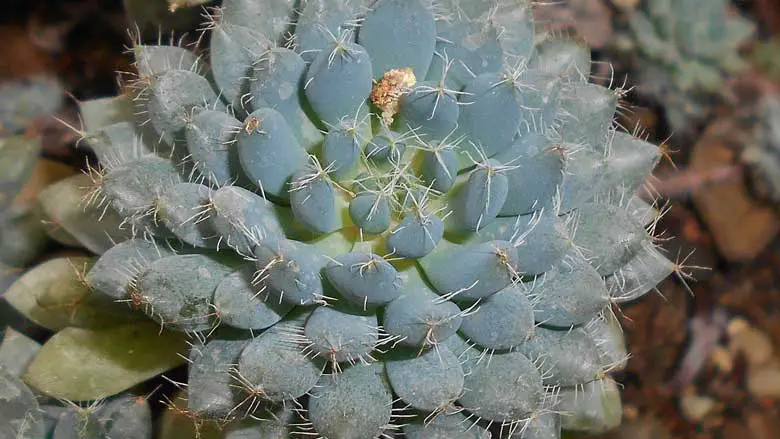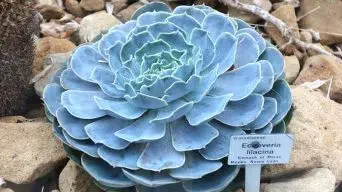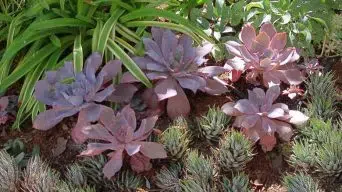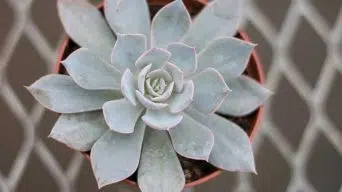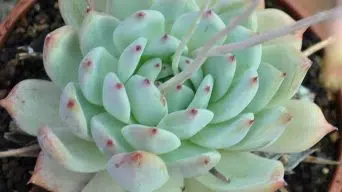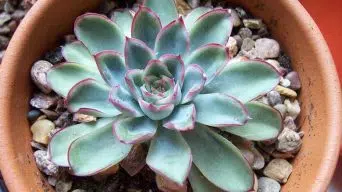Growing Echeveria plants is very easy, and they are a good choice for beginners.
There are several types of Echeveria succulent plants with different shapes, colors, and sizes.
They bear colorful and showy flowers, and they look good on a windowsill or a patio.
The Echeveria rundelli is one of the easiest succulent plants to grow that has a unique appearance, making it a popular choice for many gardeners.
Here is a complete guide about how to take care of and propagate the Echeveria rundelli succulent plant.
Overview
Echeveria rundelli, also known as Echeveria setosa var. diminuita, is a perennial succulent from the family Crassulaceae, native to Mexico.
This stemless Echeveria has dense rosettes 8 inches in diameter and pointed blue-green leaves covered in fine white hairs.
The flowers of the Echeveria rundelli are bright red to yellow and bloom on long stalks in early spring and summer,
How To Care for Echeveria Rundelli
Echeveria rundelli is a fairly easy succulent to take care of.
It is a relatively low-maintenance species, and it is not difficult to grow if you make an effort to meet its needs.
Below you’ll find the essential information you need to know about caring for Echeveria rundelli.
Sun Exposure & Light Requirements
The Echeveria rundelli succulent plant is a species that prefers full sun to partial shade.
The Echeveria rundelli requires ample sunlight to stay healthy and grow well, but it will not tolerate full sun for extended periods.
In direct sunlight, leaves may burn and turn brown from too much heat. The plant’s sap is very sensitive to sunlight and heat, so it literally cooks in the sun.
The Echeveria rundelli should receive bright indirect sunlight for about 6 to 8 hours per day for optimum growth.
When grown indoors, the Echeveria rundelli needs a west or east-facing window, as direct sunlight from a southern window will be too intense.
Watering Requirements
The Echeveria rundelli is a succulent plant requiring very little water.
It only needs to be watered when the soil surface completely dries, which will take about 1 to 2 weeks in most indoor settings.
When watering the plant, soak the soil until it drains out of the bottom of the pot. Then, let the soil dry out for about 5 to 7 days before watering again.
During winter, cut back on watering by about 25%-50%. Also, do not water during this time if the soil surface is moistened after one week.
The reason for this approach is that too much water can cause problems for this succulent plant.
If the Echeveria rundelli is put outside for the summer, it will need more water.
While in direct sunlight, water whenever the top inch or so of soil feels dry (this may be every 5 to 10 days).
Remember that when watering, we’re just talking about letting the soil surface dry out before watering again. So, do not overwater the plant during this time.
Soil Requirements
Echeveria rundelli is a succulent plant, and like all succulents, they need a well-draining soil to avoid root rot.
It also needs soil to retain water when watered so there is enough moisture for the growing season.
A good soil for this plant is a cactus mix that contains coarse sand or perlite. This allows proper drainage and water retention. It also has enough nutrients for the plant to grow.
If you want to mix your own soil, try combining a part of potting soil, a part of perlite, and a part of sand. This is the best weighing for succulents that need good drainage.
Temperature and Humidity
Echeveria rundelli is a succulent plant. This means it can tolerate hot temperatures and dry air without worrying about damage.
However, it must be protected from extreme cold to avoid harm. It should not be exposed to freezing temperatures.
Echeveria rundelli grows best when the temperature range is between 68° to 80° Fahrenheit (20 to 27°C) during the day and between 50° to 70° Fahrenheit (10to 21°C) during the night.
You will likely be able to keep Echeveria rundelli happy in such a temperature range as long as there is no extreme fluctuation between day and night.
The average humidity for this plant should be around 40% to 50%. It should be protected from very high humidity as well as from extreme dryness.
Fertilizing
Echeveria rundelli doesn’t really need any fertilizer to thrive.
If you decide to fertilize your Echeveria rundelli, use a balanced liquid fertilizer diluted to half-strength during the growing season.
Echeveria plants are sensitive to over-fertilization, so you should never fertilize them with more than half the recommended dose.
Plants that are overfertilized tend to be more susceptible to pest infestation.
Use this fertilizer from time to time if your Echeveria rundelli seems to be growing slowly and not as vigorously as it should.
Fertilizing can help the Echeveria plant grow faster, bloom more, and produce many offsets.
However, it is not required to keep your Echeveria rundelli healthy.
To grow your Echeveria rundelli well, you just need to follow the sunlight and water requirements outlined in this article.
Potting and Repotting
While Echeveria rundelli is a slow-growing succulent plant, it does not need to be repotted every month.
It will usually only need to be repotted when the root system has filled its container.
Repotting an Echeveria should only be done in late spring or early summer when its roots are still actively growing. Rundelli does not react well to repotting in the fall or winter.
Using a container with drainage holes is best because the plant will not tolerate sitting in water for extended periods.
Also, terracotta or unglazed pots are preferred to plastic or glass containers because they can more efficiently absorb water.
Choosing a container size that will accommodate the plant’s eventual size is important. When planting, add a thin layer of grit before adding soil to help with drainage and pot stability.
When repotting a Rundelli succulent, remove the old soil from the roots and replace it in a new container using new fresh soil.
Do not rake or press it down too firmly to prevent the soil from becoming compacted.
It is also crucial that you avoid damaging the roots when repotting. If necessary, remove any dead leaves.
Don’t water after planting to help keep the roots and soil from compacting. Wait a week or so before watering.
Pruning
Echeveria rundelli is a small, slow-growing succulent plant, so you won’t have to worry about pruning it often.
You will only need to prune it if you need to remove dead or dying leaves or if the leaves start to get too long.
I usually only take off the older, bigger, and more dried-up leaves so that new and smaller ones will grow in their place.
Removing dead or dying leaves regularly will prevent the plant from having too much dead tissue on it and getting diseased or infected.
If you decide to prune your Echeveria rundelli succulent plant, then be very careful not to remove too many leaves altogether.
You should try to take off just one leaf at a time so that the plant has time to recover from the pruning cut.
Pests and Diseases
Echeveria rundelli is a hardy succulent. It has few pests and diseases, but some can affect it.
Some of the most common pests and diseases that the Echeveria rundelli succulent plant is susceptible to include:
Vegetable Weevils
These small brown bugs cause damage by feeding on the leaves of the Echeveria rundelli.
They will leave black excrement marks on the leaves, and because they feed at night, this is often one of the first signs that you will see that something is wrong.
They love feeding on the insides of the leaves, so if you are noticing holes in your Echeveria rundelli leaves, this could be why.
Mealybugs
These little white bugs cover the plant and feed on its juices.
They produce a fluffy substance known as mealybug wool, a telltale sign they are around.
Mealybugs will eventually kill off your succulents, so immediately removing them from the plant is essential.
Snails and Slugs
Although this doesn’t occur very often, it’s worth mentioning, just in case.
Snails and slugs love eating succulent plants, so you should try to prevent them from coming into contact with your Echeveria rundelli by surrounding its area with copper barriers or traps.
Scale Insects
The scale insect is a tiny parasite that attaches itself to the leaves and stems of the Echeveria rundelli.
They feed on its juices, which can eventually cause enough damage to kill your plant.
Both adult scales and the eggs they lay are visible on the plant when you look closely at them.
Powdery Mildew
Although this fungus doesn’t kill your succulent plant, it will decrease its overall health and beauty.
Powdery mildew appears as a white or gray powder that you can easily wipe off the leaves and stems.
This fast-spreading fungus is caused by excess humidity and water on the leaves, so be sure to keep your Echeveria rundelli in a well-ventilated area and dry off its leaves after watering.
Root Rot
The most likely cause of root rot for your Echeveria rundelli is too much water, but other factors, such as poor drainage and the presence of pests and diseases, can also cause it.
One of the first signs you will notice when something is wrong with your plant is that its leaves will turn yellow.
You will also notice the Echeveria leaves start to fall off. It’s best to remove this succulent from its container and check the roots for any signs of rot or other problems.
Crown Rot
This disease starts the same way as root rot, with your plant’s leaves turning yellow.
However, this is due to the crown of the plant having been infected by fungi or bacteria.
It will spread to the rest of your plant very quickly, and you must take action as soon as possible if this happens.
How to Care for Echeveria Rundelli in Winter
Echeveria rundelli care involves knowing how to care for it in the winter.
These plants are not cold-hardy, so they can’t survive in winter when the temperature drops below 50° F (10° C).
When grown outdoors, it is usually grown in pots to be brought indoors or moved to a greenhouse when the weather turns cold.
In mild winters with no frost, Echeveria rundelli can be grown outdoors all year.
If you live in areas where there are cold winters, bring the potted plant inside before frost starts.
Echeveria care indoors involves reducing watering and keeping the plant in a sunny location.
The plant should be kept in a semi-shady place with temperatures between 50 and 65° F (10 and 18° C) during the day and 60 to 70° F (16 to 20° C) at night.
How To Propagate Echeveria Rundelli
Echeveria rundelli can be easily propagated from leaves and offsets. Echeveria propagation is a simple process that anyone can successfully perform.
By following a few simple steps, anyone can grow many baby Echeveria rundelli plants from just one original plant or leaf cutting.
How To Propagate Echeveria Rundelli From Leaves
Echeveria rundelli leaves are fast growers and are, therefore, ideal for this type of propagation.
The leaves must be at least two inches long with a clean surface.
To propagate your Echeveria rundelli leaves, follow these steps:
- Remove a leaf by holding it firmly at its base and twisting it gently until it comes off.
- Allow the leaf to sit for a day or two until a thin layer of brown dry skin forms on the surface. This is to prevent the propagation from getting infected with fungus and bacteria, which would cause it to rot.
- Fill a small pot or container one-third full with some succulent potting mix. Make sure that the mixture has ample drainage holes.
- Place the leaf on top of the mixture with its base against the edge of the pot. After placing your leaf, you can add another layer of soil or a little more potting mix to ensure it is firmly in place and will not fall off.
- Water the plant lightly to settle the soil around it, then water it again after a few hours. After this, try not to over-water your plant, as too much water will cause the leaves to rot.
- Place your pot in an area where it will get bright but indirect light. Ensure no hot or cold drafts are hitting your Echeveria rundelli leaf.
- Water your Echeveria rundelli plant once every two weeks.
- The cutting will root in about four to six weeks, although producing new leaves or offsets may take longer.
- Once the Echeveria rundelli plant grows new leaves or offsets, you can repot it as needed.
How To Propagate Echeveria Rundelli From Offsets
Echeveria rundelli offsets are baby plants that grow from the mother plant.
They appear as small tufts of leaves, eventually forming an entirely new Echeveria rundelli plant.
To propagate your own Echeveria rundelli offsets, follow these steps:
- Remove the offset Echeveria rundelli plant from the mother plant.
- Rinse the soil off of the roots and allow them to dry for a day or two. This prevents fungus, rot, and bacteria from harming your new Echeveria rundelli offsets.
- Plant the Echeveria rundelli offsets in a small pot filled with a cactus or succulent soil or mix. Leave about an inch of space between the leaves and the top of the soil to allow for growth.
- Water it well and place it in a sunny location without any cold drafts.
It will take a few weeks for the baby Echeveria rundelli offsets to take root and start growing. Once they do, you can move them into bigger pots as needed.
Final Thoughts
Growing succulents is all about caring for them and knowing how to propagate them well.
The Echeveria rundelli succulent plant is easy to have indoors, but it can also be planted outdoors if one lives in the right climate.
Growing them indoors requires very little care, and they can last many years when well taken care of.
If one includes Echeveria rundelli in their succulent collection, one will have a beautiful houseplant with a lot of character.

